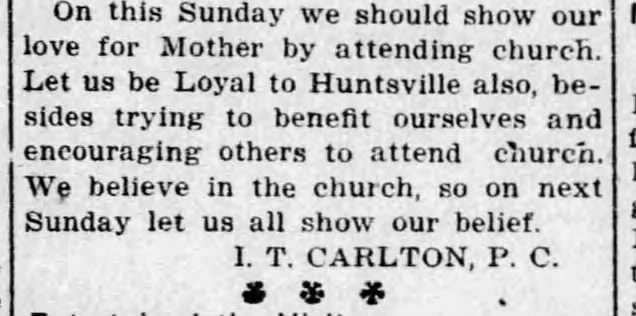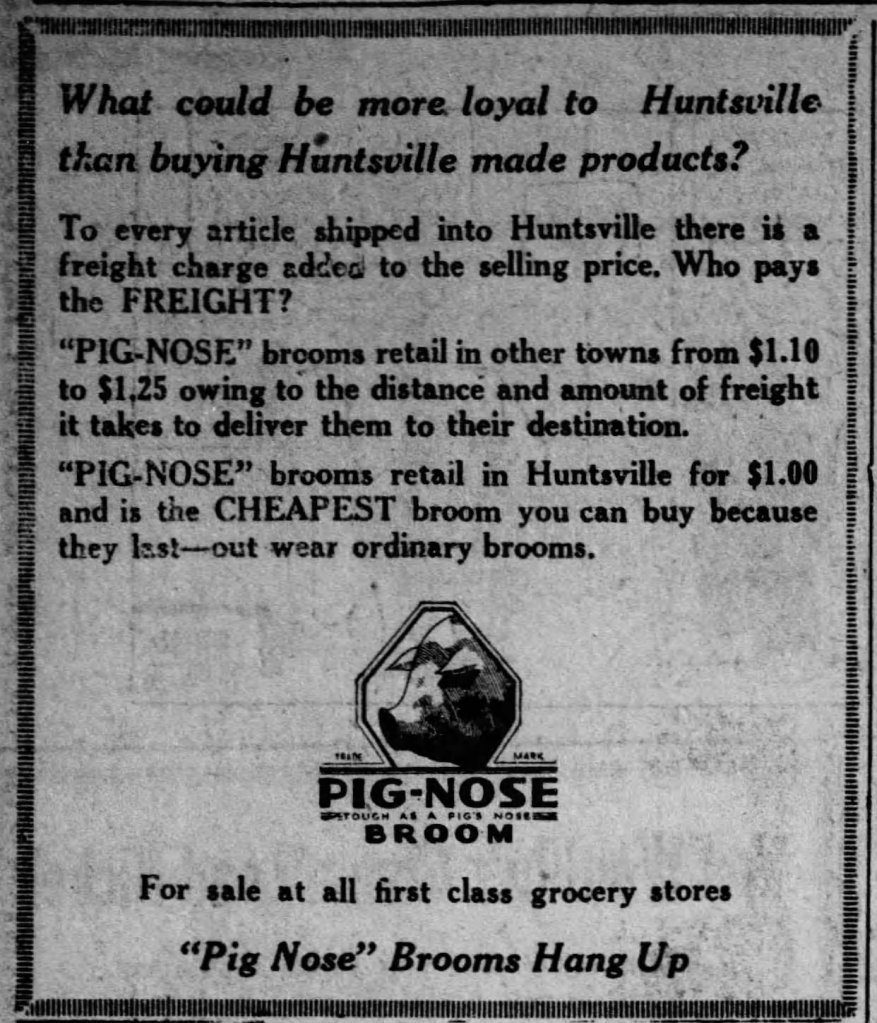https://da.mdah.ms.gov/series/territorial/s488/detail/9673
Although this blog normally focuses on North Alabama, it would be short-sighted to ignore that North Alabama was once part of the Mississippi Territory and that the norms and attitudes that prevailed there influenced how mass enslavement and plantation system developed in Madison County. Also, some historic sources are too fascinating to pass up. Here is a brief statement that recounts the trial of three enslaved men accused of robbing a fourth enslaved man during a party.
I was present this morning at a trial before Mr. Pollard in which he acted as a magistrate. The case was simply this. A Negro man of Mr. Dangerfield’s filed a complaint against three fellows for having stolen six dollars out of his chest on Wednesday or Thursday night last. My fellow Sam was one of the accused. They were examined repeatedly the evidence amounted to this. That on the night stated there had been a dance at Cato’s (who keeps a house in town) that the three accused were there after the party broke up, they went to Mr. Dangerfield’s house for the purpose of playing cards (which they had been doing at Cato’s) they were admitted and furnished with whiskey before […] to play – They broke up a little before day […] after which the money was missing on which the fellow made his accusation. He failed to substantiate the charge and my fellow was acquitted of having taken any part in the burglary, his object being to find a runaway of Mr Wm. Wright’s that is about town, for which Mr. W. offered him a reward.
The decision of the magistrate was that Mr. D’s fellow should pay him costs of court, $4.75/100 & $10 fine, of the other two fellows pay $2 ea of a fine. Mine was acquitted. He enquired if they could pay fines or when they could pay him, particularly Mr. D’s man. Who said he would as soon as he had collected some money as he had lost all he had, as stated above, but that he would pay as soon as possible. Mr. P observed he must do it even if he had to work at night & pick oakum – I suggested the propriety of having these fellows whipped instead of fined, that I thought it would have a much better effect. He observed he did not know the Laws exactly on that point but that he would inform himself or something to that amount.
[…] Dunlap was present at the greatest part of the trial.
- Mark Jackson [?]
- Natchez July 24, 1813
We can learn a lot from this brief transcript. First let’s examine all the characters mentioned.
Mr. Pollard, an unnamed enslaved man, his enslaver Mr. Dangerfield, an enslaved man named Sam, two other enslaved men with no names, Cato, Dunlap, another unnamed enslaved person who had escaped from William Wright, William Wright himself, and finally the author Mark Jackson. The original statement is incredibly faded, and the author had messy handwriting even when it was fresh, so it is possible that his name could be anything from Jackson to Isaacson. That’s twelve people in two paragraphs and at least five (possibly six) of them are enslaved.
Mr. Pollard – Almost certainly either Peter P. Pollard, who ran a magistrate office in early Natchez, or William Pollard who was the Justice of the Peace of Mobile. Either way from the way he is discussed and the deference afforded him by all involved we can work out that he’s a white man with a background in law.
Unnamed enslaved man who was robbed – Tragically the statement’s author neglected to even extend the most basic personhood to the man who brought the suit against the other enslaved men in his group.
Mr. Dangerfield – Most likely William Dangerfield, a prominent enslaver and plantation owner in Natchez who served as the acting governor of the Mississippi Territory for a time.
Sam – A man enslaved by Mr. Dangerfield. He may have been hired by William Wright to find the whereabouts of an enslaved person who escaped from Wright.
Two other enslaved men – Again, the statement’s author neglects to record their names.
Cato – A man who keeps a house in Natchez.
Dunlap – Someone who came to watch the trial.
William Wright – An enslaver whose hostage has escaped and is somewhere nearby Natchez
Unnamed enslaved person who escaped from William Wright
Mark Jackson – The author of the statement
We can learn a lot from these small glimpses. Enslaved people in early Natchez possessed a modicum of autonomy and mobility. They are socializing at night, drinking in multiple locations, and gambling. All of their movement and revelry seemingly outside the concerns of the local night watch or slave patrol. This may have been a festive occasion – there are recorded examples of festivals on plantations (Black Saturnalias) throughout the Caribbean, the junkanoo celebration that occurred in a variety of locations from Jamaica to North Carolina, and celebrations among the enslaved and free Black populations of the Northeast known as Pinkster. It may have also been the norm for what was still very much a frontier town.
Secondly, enslaved people in Natchez occasionally possessed some amount of property. The man who filed the complaint against his fellow revelers at one point owned both a chest and six dollars. Indeed, Mississippi Territorial records are replete with enslaved people who owned everyday items like chests, small amounts of cash, blankets, and a favorite set of clothes. These items technically existed at the whim of the enslaver, but allowing a touch of autonomy or sense of identity was often used to ‘soften’ the constant horrors of enslavement.
Third, enslaved people might be able to hire out their own time. This goes back to the concept of limited autonomy mentioned above. When Mr. Pollard issued his series of fines he instructed the men that they might have to work at night, implying that nights or evenings were ‘owned’ time, or pick oakum to satisfy the fines. Oakum was a type of hemp fiber that was soaked in tar and used to seal gaps in ships. Picking oakum meant that one had to tease apart the woven fibers from otherwise useless pieces of cord. The activity was tedious, irritating to the fingers, and was often meted out as a punishment, specifically an alternative to floggings, by officers in the British Navy. Convicts also commonly picked oakum to cover the cost of food and the extremely poor across the Atlantic picked oakum and sold the fibers back to ships for survival wages.
Cato presents another twist in further understanding enslaved life in Natchez. The document refers to white men as Mr. So-and-so. Enslaved people, when it bothers to name them, are called by single names. There were a handful of prominent white men named Cato, like Cato West, in the Mississippi Territory, but the lack of an honorific points to Cato either being an enslaved man or a free black who kept a house in Natchez. If Madison County’s later slave codes are anything to go by, it was not uncommon for some enslaved people in the Mississippi Territory to live apart from their enslaver and deliver goods or labor when commanded. This was especially true for those enslaved people considered ‘skilled labor.’ Cato was also an incredibly popular name for enslaved men in the United States and Caribbean. Enslavers gained an amount of sadistic and sarcastic satisfaction from naming their drudges after prominent Greco-Roman figures. All of this taken together implies either an enslaved man or recently freed Black man who kept a house in Natchez where he hosted entertainment for other members of his community.
Sam either parlayed his knowledge about a missing enslaved person into avoiding fines, or was really assisting William Wright in locating and capturing his escaped hostage. There have been other instances on this blog where enslaved people passed information to enslavers, and Sam may have been more than tempted by the prospect of payment. There are few records that I am aware of that relate to enslaved people acting as slave catchers, but Sam very well could have exploited his networks and knowledge for gain.
Lastly, the differing attitudes of the white men involved towards punishment. Pollard prefers heavy fines and labor, Jackson thinks corporeal punishment more fitting. Both men obviously disapprove of the drinking, gambling, and carousing done by those involved. Rather than acquit all of them for lack of evidence there is the urge to punish the enslaved for doing something that white men did everyday. Pollard, whose legalistic impulse is paternalistic at best, shuns the immediate violence endorsed by Jackson and relies on the classic punishment meted out to poor people of picking oakum. Jackson wants to reinforce white supremacy through bodily harm and violent punishment, to him fines are reserved for people worthy of court appearances – a status that the enslaved could never possess. Indeed, the fact he wrote a statement after witnessing Pollard presiding as a magistrate further indicates the strangeness of the situation in Jackson’s eyes.
In two short paragraphs there are innumerable glimpses into the life of enslaved people in the early Mississippi Territory, hints at the Natchez’s social organization and night life, and even competing ideas about crime and punishment in the Atlantic world. It’s a fascinating document.
Jill Lepore mentions the Black Saturnalia, Pinkster, and the relative autonomy of enslaved people living in cities in New York Burning
– p. 172 for the Caribbean celebrations
Junkanoo or Caribbean Christmas
On the importance of Pinkster to enslaved Africans in New York







